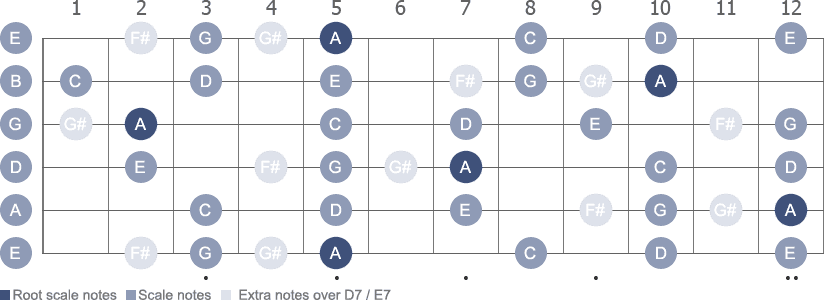Blues lead guitar - lesson 6
Blues in the key of A - backing track lesson 6.
This is the sixth lesson in the Blues soloing series with free rhythm tracks for guitar soloing. Suggested scales are presented as well as other instructions. Real-time information abut chord changes are presented to help you.
12 bar blues in A jam track (using extended scale)
"Slow Swing Blues"
Display chord changes: To see the chord changes in the field below the sound control element, you need to press the "Display chords in real-time"-button directly after you start the jam track, or click the "Start all one click"-button.

Jam track info
Instruments: Bass, drums and rhythm guitar
Chords: A7 - D7 - E7
Tempo: 60 BPM
Instructions
You can play the A Minor Pentatonic over all chords, but D7 will clash with the 5th scale degree (G), which can generate dissonance. Because of this, try to avoid G or replace G with F# over the D7 chord (not necessary in all occasions). Another possible adjustment is to add the G# note over the E7 chord. These "extra notes" is also called guide tones, which is notes that changes when the chord changes (for more theory, see "Explanations" below).
Especially on the second A7-D7 chord change, is a good idea to target the F# note since the D7 chord will span over two bars this time (it's also often easier to hear this change come, anticipate it). Another note to target in the change to D7 is the b7 interval (C in the case of D7).
For the D7-A7 chord changes, try different target notes and observe how they sound like. For example, the b7 interval in A7, which is G, can sound great as a target note here.
You can also use bends when target guide tones, by landing on the fret before and make a 1/2 tone bend. For example, if your intention is to play the G# on the 9th fret you can bend the second string on the 8th fret a semi-tone up.
When you play phrases over a chord, it will generally sound good to finish the phrase with the note which is the root of the chord (A is the root of the A7 chord etc.). Compare by ending phrases over the A7 chord with A and E notes and hear how ending on A will give the phrase more of the character that it's "finished" whereas ending on E will have a character of that the phrase still waiting to be continued. Temporarily end on E can be great as well, since it will give a feeling of anticipation (but you must follow up in these cases).
Explanations
Primary and secondary notes - One of the most essential aspects of soloing over scales is to accentuate notes in the chords. So, if the A7 chord is played, A, C#, E and G are especially critical notes. The remaining notes in the scale are also important, but can be seen a secondary. The secondary chords are although important to bind together phrases and can be seen as passing notes.
Scale and chord relationship - Scales that are suitable to use over chords are normally including the same notes as the chords, or at least including the majority of notes as the chords.
Look at the following comparisons:
Am Pentatonic scale degrees and notes.
| 1 | b3 | 4 | 5 | b7 |
|---|---|---|---|---|
| A | C | D | E | G |
A7 chord chord intervals and notes.
| 1 | 3 | 5 | b7 |
|---|---|---|---|
| A | C# | E | G |
D7 chord chord intervals and notes.
| 1 | 3 | 5 | b7 |
|---|---|---|---|
| D | F# | A | C |
E7 chord chord intervals and notes.
| 1 | 3 | 5 | b7 |
|---|---|---|---|
| E | G# | B | D |
Interestingly, in blues, a minor scale (which tends to be a pentatonic scale type) is often used over major or dominant chords, which generate several note mismatches. But since it sounds good, this is not a problem. But one way to relate to these divergences is to adjust the soloing depending on which chord is played over. Details can be seen under "instructions" in the specific jam track window. By comparing A7, D7 and E7, it will be clear which the match and guide tones are.
Guide tones - The tables show which that are the guide tones in different chord changes.
A7-D7 chord changes guide tones and intervals.
| 1 | 3 | 5 | b7 |
|---|---|---|---|
| F# | C |
D7-A7 chord changes guide tones and intervals.
| 1 | 3 | 5 | b7 |
|---|---|---|---|
| C# | E | G |
A7-E7 chord changes guide tones and intervals.
| 1 | 3 | 5 | b7 |
|---|---|---|---|
| G# | B |
So, as an example, when the chord changes from A7 to E7, the tones that can be targeted to highlighting the E7 chord are G# or B. It is, of course, nothing wrong by instead target E (the root) or D (the by interval) in the A7-E7 change, but this will not underline the new chord to the same degree.